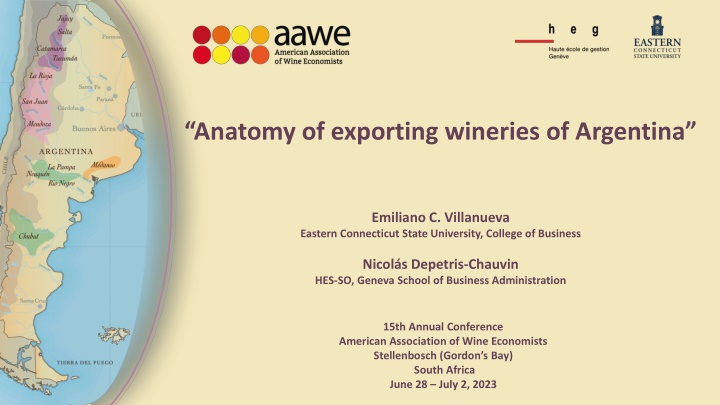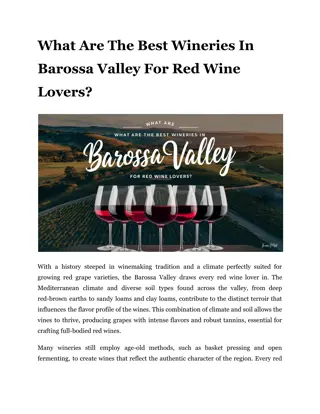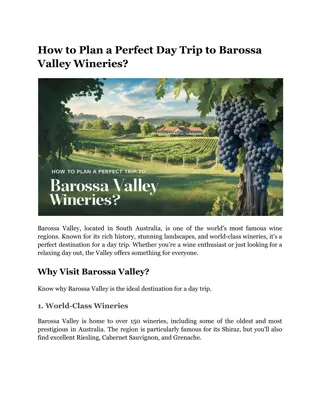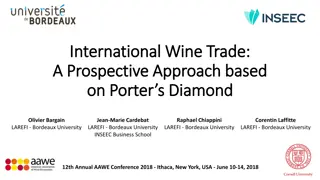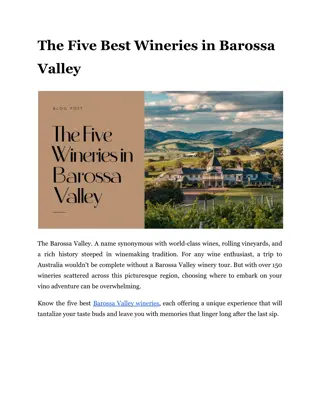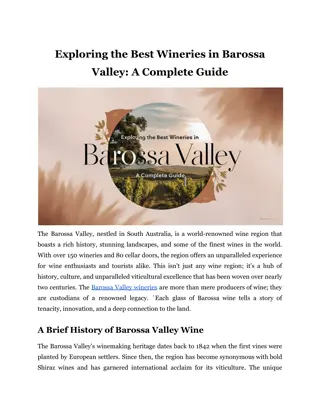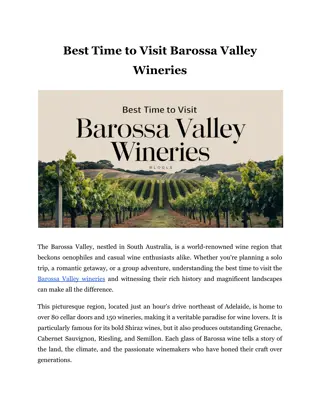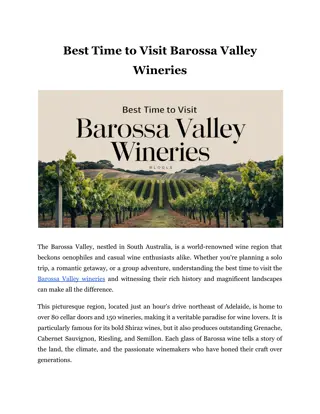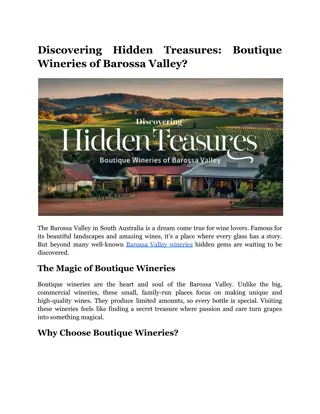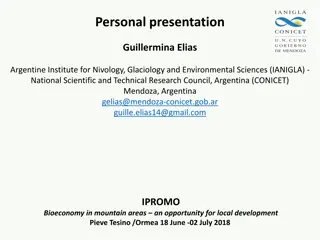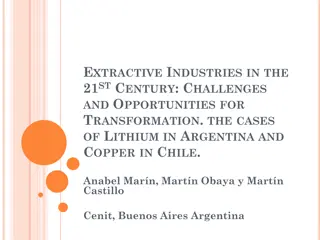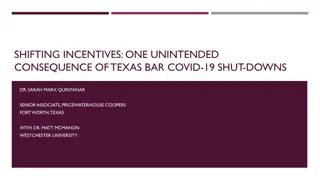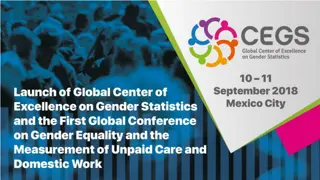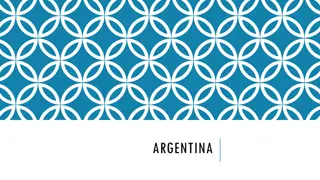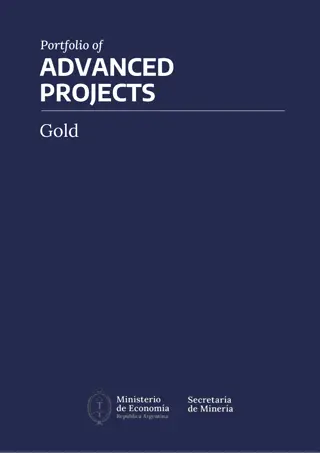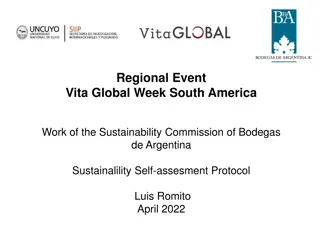Anatomy of Exporting Wineries in Argentina
Study conducted by Emiliano C. Villanueva and Nicolás Depetris-Chauvin analyzing the export strategies of wineries in Argentina. The research was presented at the 15th Annual Conference of the American Association of Wine Economists, shedding light on the key aspects of the country's exporting wineries.
Download Presentation

Please find below an Image/Link to download the presentation.
The content on the website is provided AS IS for your information and personal use only. It may not be sold, licensed, or shared on other websites without obtaining consent from the author.If you encounter any issues during the download, it is possible that the publisher has removed the file from their server.
You are allowed to download the files provided on this website for personal or commercial use, subject to the condition that they are used lawfully. All files are the property of their respective owners.
The content on the website is provided AS IS for your information and personal use only. It may not be sold, licensed, or shared on other websites without obtaining consent from the author.
E N D
Presentation Transcript
Anatomy of exporting wineries of Argentina Emiliano C. Villanueva Eastern Connecticut State University, College of Business Nicol s Depetris-Chauvin HES-SO, Geneva School of Business Administration 15th Annual Conference American Association of Wine Economists Stellenbosch (Gordon s Bay) South Africa June 28 July 2, 2023
Anatomy of exporting wineries of Argentina Objectives Characterize Argentine wine industry structure in terms of export intensity Winery characteristics Price segments Differentiation Capabilities Business strategies Export constraints and performance Compare with wineries in similar exporting countries Second tier exporting countries Aspirational Third tier exporting countries
The survey 45-minute questionnaire Answered on-line by either the winemaker, enologist, cellar master, operations director, sales manager, PR manager, vineyard manager, or owner of the winery 137 questions in 5 sections Winery profile and characteristics Value chain, differentiation Capabilities and business strategies Export activities and constraints Innovation type and creative process Distributed along all wine regions of Argentina Between September 2019 and May 2021
The sample 230 complete answers 152 in Mendoza Sample is representative
Argentine Wineries by Export Intensity Not Low Intensity Exporter Medium Intensity Exporter High Intensity Exporter Exporting (exports less than 30% of their volume production) (exports between 30% and 50% of their volume production) (exports above their 50% volume production) 28.70% 30.00% 17.83% 23.48% 66 wineries 69 wineries 41 wineries 54 wineries
Argentine Wineries by Export Intensity 164 exporter wineries (71.3%) and 66 non-exporter wineries (28.7%) Two-third of non exporting outside Mendoza The smaller the producing region is, the more non-exporting wineries the region has 85.5% of wineries in Mendoza are exporters against 43.6% in rest of the country Mendoza: 32.23% of all wineries are high intensity exporters 54 High Intensity Exporters: 49 in Mendoza, 3 Northwest, 1 in Cuyo, 1 in Patagonia 70% of the exporting wineries are Corporations (Sociedad An nima) 83% highly intensive exporters are corporations 62% of non-exporting wineries are not corporations ~30% of high intensity exporters are foreign owned companies Foreign ownership increases while export intensity increases 94% of non-exporting wineries are locally owned
Size and Vertical Integration Vertical Integration: Own Harvest Average Years in the Market Average Surface in Hectares Median Surface in Hectares 100% 0% Not exporting 18.8 22.3 7.0 56.1% 16.7% Low intensity exporter 30.4 147.4 55.0 31.9% 15.9% 1/3 Medium intensity exporter 34.6 348.4 40.0 24.4% 4.9% High intensity exporter 27.8 285.5 85.0 33.3% 3.7% Non- exporting wineries are younger, smaller, more likely to be fully integrated or not have vineyards Exporting wineries have the bigger surfaces in vine production and the major average of annual production of wine by volume in liters High-intensity exporters are larger, mixed of old and young, very likely to have vineyards, buy grapes but less than other medium-intensity exporters
Price segments Price segment and export intensity Iconic (+100$) Luxury (40-100$) * Premium (10-40$) Value (-10$) 0.0% 10.0% 20.0% 30.0% 40.0% 50.0% 60.0% 70.0% 80.0% 90.0% 100.0% 4-High intensity exporter 3-Medium intensity exporter 2-Low intensity exporter 1-Not exporting
Differentiation I > 25% from other activities Range Differen tiation Median grapes vinified Median labels produced Three most important steps entry level wine Three most important steps premium level wine Fermentation - Bottling - Harvest Not exporting 21.2% 62.12% 5.0 4.0 Aging - Fermentation - Harvest Distribution - Fermentation - Maturation control Product design - Distribution - Fermentation Aging - Maturation control - Product design Low intensity exporter 21.7% 84.06% 7.0 8.0 Medium intensity exporter Aging - Maturation control - Grape sorting 22.0% 87.80% 6.0 10.0 High intensity exporter Harvest - Product design - Distribution Blending - Aging - Maturation control 14.8% 94.44% 7.5 12.5
Differentiation II Yields - Premium Kg/SqM Yields - Entry Kg/SqM High intensily exporter more likely to: Canopy management differentiation Green harvest Grape sorting Malolactic fermentation Aging Mean Median Mean Median Not exporting 1.3 1.0 1.2 0.8 Low intensity exporter 1.2 1.2 0.8 0.8 Medium intensity exporter 1.4 1.3 0.9 0.8 High intensity exporter 1.2 1.1 0.7 0.7
Capabilities I: Human Resources English spoken by permanent employee Permanent employees (median) Temporary employees (median) Years experience owner Agronomy degree Oenology degree Business degree Not exporting 3 10 36.4% 56.1% 9.1% 40.9% 14.1 Low intensity exporter 10 15 53.6% 82.6% 62.3% 66.7% 22.8 Medium intensity exporter 10 15 70.7% 82.9% 65.9% 75.6% 23.2 High intensity exporter 24 25 77.8% 81.5% 75.9% 81.5% 18.8 Wineries that export have: the major average number of permanent employees the major proportion of employees with a university degree a propensity to have more business and marketing professionals
Capabilities II: Equipment Medium intensity exporter High intensity exporter Not exporting Low intensity exporter Grape sorting table 27.3% 47.8% 68.3% 74.1% Grape crusher 71.2% 79.7% 80.5% 75.9% Presser 78.8% 94.2% 92.7% 94.4% Tanks 89.4% 95.7% 92.7% 96.3% Pumps 86.4% 98.6% 92.7% 96.3% Filters 60.6% 73.9% 58.5% 72.2% Bottling equipment 59.1% 52.2% 48.8% 53.7% Automated winery control 9.1% 23.2% 34.1% 29.6% Under vine weeders 36.4% 47.8% 61.0% 63.0% Pre pruners 10.6% 26.1% 36.6% 44.4% Trimmers 7.6% 17.4% 34.1% 24.1% Sprayers 68.2% 81.2% 82.9% 90.7% Shredder 18.2% 20.3% 31.7% 33.3% Picking machine 3.0% 21.7% 22.0% 31.5% Tractors 69.7% 87.0% 82.9% 90.7% Irrigation 59.1% 65.2% 73.2% 83.3% Automated vineyard control 6.1% 11.6% 19.5% 14.8% Crops cover 34.8% 42.0% 53.7% 64.8% Simple average 44.2% 54.8% 59.2% 63.0%
Business Strategies I: Competitive Method Innovation in marketing 4.5 Products in higher priced segments Pricing below competitors Products in lower priced segments New product development 4 3.5 Innovation of production Broad product range 3 2.5 Concerned efforts to build reputation Efforts for trained personel 2 1.5 Promotion advertising expenditures abore average Quality control 1 Emphasis on manufacturing specialty products Overriding concerns for lowest unit cost Only serve specific geographic markets Maintaining high inventory Major expenditure on prod process oriented RnD Limited product range Major efforts to insure availability of inputs Building brand identification Strong influence over distribution channels Developing existing products 1-Not exporting 2-Low intensity exporter 3-Medium intensity exporter 4-High intensity exporter
Business Strategies II: Perceived Strength Organisational skills 4.5 4 3.5 Marketing Technology 3 2.5 2 1.5 1 Human resources Innovation Information and cooperation Quality 1-Not exporting 2-Low intensity exporter 3-Medium intensity exporter 4-High intensity exporter
Business Strategies III: Competition level 4.5 4 3.5 3 2.5 2 1.5 1 Access to distribution channels Product characteristics Promotional characteristics Barriers to entry 1-Not exporting 2-Low intensity exporter 3-Medium intensity exporter 4-High intensity exporter
Business Strategies IV: Promotion & Distribution Promotion More important: word of mouth, direct marketing, online marketing Less important: sponsorships, wine clubs, international contest Order of importance is similar for the four categories of export intensity Distribution More important: direct sales and distributors Less important: wine clubs and wine fairs Direct sales are more important for non exporters Distributors are more important for exporters Internet still not important
NON-EXPORTERS 15% not looking to export: scale main concern 85% of non exporters would like to export in the future Main motivation to export in the future Develop and diversify my business Decreasing domestic demand less of a concern Importance of factors to be able to export More important: exchange rate, marketing and logistics, reliability of trading partners Less important: language barrier, domestic competition, uncertainty of regular orders Perceived most attractive market: Asia, followed by North America
EXPORTERS Export experience How many (average) 1-5 years > 20 years Countries Labels Low intensity exporter 36.2% 8.7% 4.7 8.9 Medium intensity exporter 26.8% 22.0% 16.2 10.0 High intensity exporter 9.3% 16.7% 15.4 14.0
Export Performance I: Satisfaction 4.50 4.00 3.50 3.00 2.50 2.00 1.50 1.00 Export volume Value per bottle Number of countries exported Number or labels exported Export logistics International brand recognition 2-Low intensity exporter 3-Medium intensity exporter 4-High intensity exporter
Export Performance II: Factors Financial resources 4.5 Uncertainty of regular orders Your production costs 4 3.5 Language barriers Custom duties (origin) 3 2.5 2 Finding trading partners Exchange rate 1.5 1 Reliability of trading partners Country image abroad Domestic competition Custom duties (destination) Marketing and logistics costs Size of your winery National export promotion agencies 2-Low intensity exporter 3-Medium intensity exporter 4-High intensity exporter
Export Performance III: Adapt to Export 4 3.5 3 2.5 2 1.5 1 Grape varieties Terroir selection Agronomic practices Blending Aging Bottling and capping Labeling Promotion Distribution Pricing 2-Low intensity exporter 3-Medium intensity exporter 4-High intensity exporter
INTERNATIONAL COMPARISONS: EXPORT INTENSITY STRUCTURE Low Intensity Exporter Medium Intensity Exporter High Intensity Exporter Not Exporting (exports between 30% and 50% of their volume production) (exports less than 30% of their volume production) (exports above their 50% volume production) Argentina 28.70% 30.00% 17.83% 23.48% Australia 43.21% 40.74% 9.88% 6.17% Chile 34.69% 15.31% 10.20% 39.80% South Africa 5.76% 32.37% 30.22% 31.65%
INTERNATIONAL COMPARISONS: BASIC CHARACTERISTICS COMPARISON OF HIGH INTENSITY EXPORTERS ACROSS COUNTRIES Vertical Integration: Own Harvest Average Years in the Market Median Surface in Hectares 0% 100% Argentina 27.8 85.0 3.7% 33.3% Australia 36.6 12.0 0.0% 20.0% Chile 26.3 38.0 17.9% 30.8% South Africa 73.4 50.0 11.4% 31.8%
INTERNATIONAL COMPARISONS: DIFFERENTIATION COMPARISON OF HIGH INTENSITY EXPORTERS ACROSS COUNTRIES > 25% from other activities Median grapes vinified Median labels produced Range Three most important steps - entry Three most important steps - premium Differentiation Harvest - Product design - Distribution Blending - Aging - Maturation control Argentina 14.8% 94.44% 7.5 12.5 Blending - Harvest - Fermentation Blending - Aging - Canopy Management Australia 20.0% 100.00% 6.0 7.0 Fermentation - Distribution - Harvest Aging - Grape Sorting - Harvest Chile 12.8% 82.05% 8.0 12.0 Blending - Harvest - Distribution Blending - Aging - Canopy Management South Africa 11.4% 77.27% 8.0 4.0
INTERNATIONAL COMPARISONS: CAPABILITIES COMPARISON OF HIGH INTENSITY EXPORTERS ACROSS COUNTRIES English spoken by permanent employee Permanent employees (median) Temporary employees (median) Years experience owner Agronomy degree Oenology degree Business degree Equipment index Argentina 24 25 77.8% 81.5% 75.9% 81.5% 18.8 63% Australia 21 10 20.0% 60.0% 40.0% 100.0% 30.8 51% Chile 17 20 84.6% 87.2% 59.0% 87.2% 22.7 55% South Africa 15 20 25.0% 90.9% 47.7% 93.2% 24.5 56%
INTERNATIONAL COMPARISONS: BUSINESS STRATEGIES COMPARISON OF HIGH INTENSITY EXPORTERS ACROSS COUNTRIES Three most important strategies Three least important strategies 1. Promotion advertising expenditures above industry average 1. Quality control 2. Building brand identification 2. Products in lower priced segments 3. Major expenditure on prod process oriented R&D 3. Developing existing products 1. Concerned efforts to build reputation 1. Products in lower priced segments 2. Emphasis on manufacturing specialty products 2. Overriding concerns for lowest unit cost 3. Major expenditure on prod process oriented R&D 3. Products in higher priced segments 1. Promotion advertising expenditures above industry average 1. Building brand identification 2. Quality control 2. Pricing below competitors 3. Developing existing products 3. Products in lower priced segments 1. Promotion advertising expenditures above industry average 1. Quality control 2. Developing existing products 2. Products in lower priced segments 3. Concerned efforts to build reputation 3. Pricing below competitors
INTERNATIONAL COMPARISONS: FACTORS AFFECTING EXPORTS COMPARISON OF HIGH INTENSITY EXPORTERS ACROSS COUNTRIES Three most important factors Three least important factors 1. Exchange rate 1. Language barriers 2. National export promotion agencies 2. Custom duties (origin) 3. Country image abroad 3. Domestic competition 1. Country image abroad 1. Language barriers 2. Custom duties (destination) 2. Custom duties (origin) Emerging vs. Developed Economies 3. National export promotion agencies 3. Size of your winery 1. Country image abroad 1. Language barriers 2. Exchange rate 2. Domestic competition 3. Finding trading partners 3. Custom duties (origin) 1. Exchange rate 1. Language barriers 2. National export promotion agencies 2. Country image abroad 3. Your production costs 3. Domestic competition
CONCLUSIONS Highly intense exporting wineries is a Mendoza phenomenon Highly intense exporting wineries: Larger and more vertically integrated Operate in all price segments, dominate high price segments Less dependent on other income generating activities More likely to differentiate, more grape varieties, more labels More emphasis on quality, also on product design and distribution Higher human and equipment capabilities, not necessarily more experience Competitive method: quality control, brand identification building, continuous development of existing products Perceive themselves as stronger in quality, weaker in marketing Competition is strong on product characteristics Promotion strategy similar to other wineries Distributors are key
CONCLUSIONS Export satisfaction increases with export intensity Stronger for number of labels, weaker for number of countries Factors affecting exports More important: exchange rate, custom duties (own), country image Less important: language barriers, export promotion agency, domestic competition Adaptation to export: moderate, stronger for export intensive wineries More important: pricing and distribution Less important: grape variety and terroir selection
CONCLUSIONS Export intensity structure Middle class more important in Argentina than in Chile Higher proportion of export intensive firms in South Africa and Chile (smaller domestic market) Argentinean higher export intensive firms Larger than in Chile, Australia, and South Africa More vertically integrated Similar differentiation strategies Can compete in terms of capabilities Strong convergence in the industry Wineries have similar business strategies (except for Australia) around quality control, continuous improvement and branding Exchange rate (except for Australia) and country image are important export factors Export taxes only a factor in Argentina.
CONCLUSIONS Exporting wineries characteristics may show a path for progress in a steadily growing industry Exporting wineries in Argentina tend to be more innovative, technologized, and open to explore with new wines Scale has shown to be an important element to create the cluster environment that allows real chances for feasible exports The leading ten exporting wineries' business model influence the rest: bottled Malbec wine of quality from Mendoza at an affordable American middle-class consumer target This scope may present some constraints and challenges in the immediate future
Anatomy of exporting wineries of Argentina Emiliano C. Villanueva Eastern Connecticut State University, College of Business Nicol s Depetris-Chauvin HES-SO Geneva, School of Business Administration Thank you! Any questions?
